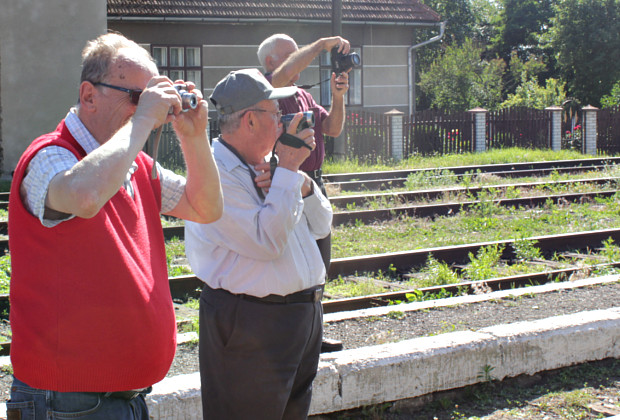16 July 2015
Yesterday we returned from the difficult and very exciting journey to Transnistria. The journey was organized by “The World Organization of Bukovina Jews“.
We heard personal stories of those who were children and personally experienced the horrors of this (WW2) dark period. We had meetings of third and fourth-generation of holocaust survivors with places and stories where their ancestors were – remnants of a glorious Jewish culture that was destroyed and erased at once.
We (I and Yossi) went personally to the small village where Yossi’s family: his father- Kupferschmid Hersh Zvi, his mother Rene (Reiner) and his aunt Kupferschmid Loti lived before the expulsion to Transnistria – Malyatinetz- MALYATYNTSI.
We had a warm meeting with the local people who tried hard to help. We found and looked at a book with birth-records since in 1903. We did not find any name of our families. The manuscript book was very consistent throughout the years, and I think that registration was done in later years – maybe as part of a village population information recording during the census, while adding date of birth. Later, when the person died they probably added the date of death. Of course, our family was no longer in place at the time of the census.
The villagers did not remember anything about a Jewish cemetery or synagogue in Malyatinetz.
We were brought to the former school principal, Mr. Ciqevski Vasil, who is 77, retired. In other words – he was a child during the Holocaust and could not remember anything.
Then they took us to a sign of what they called “Monument Hibraiikh” (Monument of the Jews, Jew’s Monument). It is located about 5 km northwest of the village, in agricultural fields, on moderately descending slope stands a 7 branches lamp, made of concrete, about 4m high, painted in reddish-brown.
It seems clear that at the lamp base was a memory plaque, probably stating the date and event in memory of which that monument was established. We searched around and did not see the remnants of the plaque. The locals told us that the monument is in memory of local Jews from the surrounding villages that were brought to this area, murdered and buried in a mass grave at that place.
Unfortunately, communication with the locals was very hard. We do not speak Russian or Ukrainian and the driver and the locals knew very little English… Only the good will, using mimics and terms of international communications allowed very minimal understanding.
Unfortunately, our phone did not have access to the Internet and we could not connect to the network to get exact location of the scene. Nevertheless, I managed to locate (using Google map) the tree next to the monument – the GPS coordinates based on the map are:
48 ° 32’56.3 ” N 25 ° 36’28.0″ E 48.548969, 25.607771
We also took pictures of the monument and the village. They are attached hereafter.
I continued to search and found additional materials about the monument by searching about the nearest village – Siskovitz (Now called Shyshkivtsi; Please note that there are several other places with same name). Indeed, I found perfect and chilling evidence (in terms of scope) in the book “The Holocaust of Northern Bukovina Jews” about Siskovitz and Iozinetz (Yuzhynets) – the end of the two communities. (pp 536-546). It describes the massacre of the Jews, references many names and tells of the establishment of this monument in 1992, by local residents, non-Jews, who could not forget the terrible sights.
See attached Google map with Malyatinetz, Shyshkivtsi, Yuzhynets marked:
Malyatinetz map
Kfir Yael and Yossi, Israel
+972-52-836-5145






























































